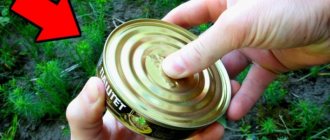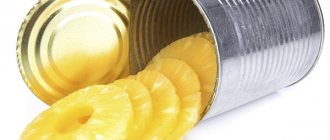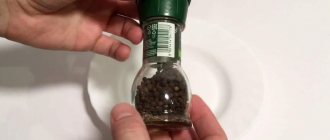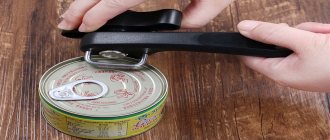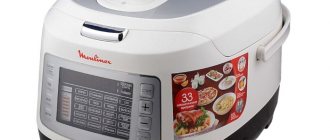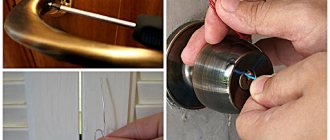Methods for opening a jar with a screw cap
Most canned goods today have just such metal lids.
This applies to both those sold in the store and home supplies. Such a blank will open easily when the pressure inside and outside the can becomes the same. To do this, you need to let air into the jar. As a rule, a rotational movement counterclockwise with a slight force, a slight pop or hiss indicating the entry of air - and the job is done. If you cannot open it the first time, it is recommended to attract the brute masculine power of assistants from among your friends and relatives. But how do you open a jar with a screw cap if even then it won't give in? You will have to use improvised means, folk methods or special devices.
The use of improvised means and folk methods
The easiest and fastest way is to let air in by slightly bending the side of the lid. This can be done with an old knife or any other fairly hard object that can pick up the edge: a can opener, an awl, a metal ruler, cutlery.
Carefully inserting a knife or other improvised object between the lid and the jar, you need to make a movement that bends the iron away from the glass. Having heard the sound characteristic of air penetrating inside, then unscrew the lid by hand.
Among the folk methods of solving the problem of how to unscrew the lid on a jar, there are also such variations of mechanical impact:
- sharply hit the bottom, holding the inverted can in weight;
- tap the lid and sides of the jar with different objects, for example, a knife handle or a kitchen spatula;
- roll the jar sideways on the table, then press the middle of the lid with your hand.
Unfortunately, they are ineffective.
Sometimes it seems that the lid is about to give in, so it’s a pity to spoil it with a knife or awl. But at the most crucial moment, your hands become painful, or they begin to slip. To protect the skin of your hands, increase the adhesion force and at the same time not damage the lid, use:
- a damp kitchen towel or rag, which is used to cover and then rotate the lid;
- rubber gloves, either thick kitchen gloves or latex medical gloves;
- cling film for covering the lid, which is recommended to be degreased beforehand;
- leather belt.
The belt is used as follows:
- thread the belt through the buckle, forming a loop;
- place a loop on the lid around the rim:
- tighten firmly in a counterclockwise direction;
- twist the jar clockwise, while simultaneously pulling the lid in the opposite direction using a belt.
In the case of the belt, the laws of physics regarding friction are used.
The same science is applied by lowering the lid of a jar into hot water. In this case, the law of thermal expansion applies - since metal expands more than glass when heated, the lid becomes wider than the rim and is easier to open. To achieve the desired effect, it is enough to keep the jar in water for 10–15 minutes. After this, it is recommended to wipe it dry so that the laws of friction work better when unscrewing. The method works well not only for new, but also for re-opening cans with sweet contents. When soaking, hot water gets under the lid. Although it leaks out in microscopic doses, it is usually enough to dissolve the sugar crystals and eliminate the mechanical interference they create.
Use of special devices
A special device for opening glass containers is a key, sold in most large hardware stores. It is a round rim with handles and operates on the principle of tongs:
- the rim is placed on the lid;
- a person squeezes the handles with his hand, reducing the diameter of the rim as much as possible;
- thus, the lid is tightly grasped by these “round” tongs;
- Without unclenching the handles, so as not to loosen the grip, the person makes a rotational movement counterclockwise;
- In addition to the tight clamp, the lever effect that the handles provide contributes;
- a complex of efforts leads to opening the can.
In recent years, online trading has offered other options for special devices made of plastic, latex, and other materials.
But for the most part, they use the same methods of influencing the lid as the described key, which remains the most famous and popular among consumers. We recommend:
How to clean a washing machine from mold and odor inside
How to easily open a glass jar with a screw cap
First, you need to prepare your hands. The jar will open faster if they are very low-fat and dry. The same applies to the jar itself and the lid. You can try holding the jar with your feet to make it easier to twist, but the experts offer another rationalization: not unscrew the lid from the jar, but the opposite.
When opening the lid, hold the lid in your left hand and the jar in your right and twist the jar more than the lid.
Improving the grip
Grasp the jar and lid more tightly - and all your useful effort will be directed in the necessary direction. You will still have to apply force, but the opening will be even faster and easier. Several favorite methods for unscrewing caps are based on this physical fact:
- You can use special devices designed to open this type of cans.
They are inexpensive, and save a lot of effort and nerves. - If you don’t have a special opener yet, here’s the classic method: open the jar, strengthening the grip between your hand and the lid using the gasket. You can take a towel or cloth for this, grab the lid tightly and try to turn it. In half the cases this is enough.
- If that doesn't work, try wearing rubber gloves and opening with them.
- Retro option. Take a leather belt and thread it through the buckle. Throw the resulting loop over the lid of the jar and tighten it as tightly as possible.
Pull the belt, turning the loop together with the lid in such a way that the can moves clockwise and the lid moves in the opposite direction. This method was even published in books on home economics!
Let's deform
Deformation of the lid also gives good results in opening canned food. There are two options:
- Take the jar, place it on its side and roll the lid along the edge of the table, pressing gently.
Remember that the jar must be lower, outside the table. Continue until the lid is slightly deformed, air gets under it, and you hear a corresponding pop. Return the jar to a vertical position and open. - Try simply turning the lid of the jar over onto your palm and simply tapping it on the bottom. Then turn it over and hit the lid in the same way: it should wrinkle. After this, no significant effort is required to unscrew.
Heating
Place the top of the jar in a container of hot water with the lid down, hold for 3-5 minutes and then open. Alternatively, you can simply place the jar under running hot water.
You can also take boiling water and lightly pour it on top of the lid, and then open it through a towel, because the lid will get extremely hot. According to the laws of physics, the lid expands slightly due to the action of hot temperature, and after this it will be easy to unscrew it.
Let's pry
Use a serving knife with a blunt rounded end, a teaspoon, or another clean object with a fairly narrow end.
Carefully lift the lid with it and turn it slightly, placing it between the lid and the jar.
The edge of the lid should move away from the jar at this moment. As a result, the seal will be broken, a soft bang will be heard, after which the lid will simply open. In terms of effectiveness for opening hermetically sealed cans, this method is one hundred percent effective.
Lubricate
Perhaps you have encountered a situation where the lid is not hermetically sealed, but simply stuck to the jar due to the sweet contents - honey or jam.
Then tricks with air intake will not work. Place the jar with the lid down and add a few drops of any vegetable oil, trying to get between the lid and the neck of the jar. Wait until the oil is distributed evenly, this will take about 10-15 minutes. Then turn the jar over, take a towel or put on rubber gloves and unscrew.
How to easily deal with a screw cap
Most often, such jars open without much difficulty, but sometimes, no matter how hard you try, nothing works. One of my friends constantly performs a funny trick: with the words “Open up, police!” taps the lid with his finger, and then unscrews it with a slight movement of his hand. I don’t understand how she does this, it doesn’t work for me. But fortunately, there are many other proven methods.
- Use a special key. It's good if you have a special can opener for such lids in your kitchen drawer. It works both for twisting and unscrewing, without damaging either the glass of the jar or the lid. Maybe it’s worth purchasing it, especially since it’s so inexpensive?
- Hit. The easiest way to open a jar without a key is to turn it over and, holding it suspended, slap the bottom, or, conversely, place it on your palm and hit the lid. It almost always works, except in very difficult cases when the problem is not the vacuum, but the fact that the lid is stuck.
- Increase the coupling. If the cause of difficulty is your hands slipping, proceed as follows. The jar, lid and hands should be dry and grease-free. Put a rubber or silicone glove on your hand (regular gloves you use when washing dishes work well). In mild cases, you can get by with a kitchen towel. Polyethylene film increases the grip of the lid and the hand very well. Sandpaper can also help. Place some kind of “gasket” on the lid and start unscrewing the jar from the lid, and not vice versa. True, you still have to apply a considerable amount of torque. And if your hands also hurt, then this method is definitely not for you.
- Use the laws of physics. Take a leather belt and thread it through the buckle. Throw the resulting loop over the lid and tighten it tightly, directing it counterclockwise. Then rotate so that the can goes clockwise and the lid goes counterclockwise.
- Knock. Gently tap the top and sides of the tight lid with something wooden or plastic - a spatula, the handle of a knife. Do this carefully so as not to damage the jar. If the reason is not that the lid is too worn in, after such manipulations the jar will open without difficulty.
- Take it for a ride. A simple method often helps: place the jar on its side, and roll the edge of the lid along the edge of the countertop several times back and forth, slightly pressing on top with your hand. The tightly pressed surface of the edge of the lid will relax a little, making a quiet pop, after which the jar will open quite easily.
- Heat. Fill a bowl with hot water and place the jar in it with the lid down. Leave it like this for 10 minutes, then remove it and open it. Running hot water will also work well if you place the illumination jar under an open tap. When exposed to heat, the lid expands and is easier to unscrew. You can also place a very hot towel on the lid. And the fastest way to heat the lid is boiling water: just pour it over the sink directly from the kettle for a few seconds.
- Depressurize. Is the problem that the cap has retracted too much under the vacuum? This means you need to ensure air access inside the can. Insert a table knife between the neck and the lid and carefully turn it a little, moving the edge of the lid to the side, away from the glass. A gap of 0.5 mm is enough for depressurization to occur.
- Lubricate the thread. For jars with honey and jam, this method is suitable: place the jar upside down, and drop a little vegetable oil in several places between the neck and the lid. Leave for 15–20 minutes. This time should be enough for the oil to penetrate into the cracks, lubricate the surfaces and make it easier to unscrew the lid.
in complex therapy using Montbalsams
Vacuum reflexotherapy has a very long history. Apparently, its origins can be attributed to the most ancient methods of healing that came to us from China. Already in ancient times, people understood the prospects of rarefied air treatment. Initially, ceramics or even animal horns, hollow inside, were used for these purposes. Then the familiar glass jars appeared. The peak of their heyday and popularity occurred at the beginning - mid-twentieth century. The use of cans is still widespread among many nations. And the first description of the use of cans dates back to the 16th century BC. e.
Currently, treatment with medical cupping is regaining popularity. In the modern world, the Chinese Institute of Reflexology is a leader in the use of this technique.
The therapeutic effect of the technique is based on strengthening the immune system and the functioning of internal organs. The positive aspects are as follows: blood flow under the skin increases significantly, and metabolism accelerates accordingly. Vacuum therapy enhances peripheral blood circulation and reduces congestion in tissues. Improves skin and muscle nutrition. Toxic or under-oxidized breakdown products come to the surface of the skin.
The healing properties of jars are beyond doubt. They help the body fight the disease, as mentioned above, by strengthening the functioning of the immune system. Banks have also proven themselves to be excellent in complex therapy.
Tissues are better supplied with oxygen and other useful substances. As a result, inflammatory processes disappear faster. The body begins to more actively fight the infection. But for the procedure to bring real benefits, you need to learn how to place the jars correctly.
The essence of vacuum reflexotherapy is that negative pressure is created under the cups, which promotes the activation of the body’s immune system, accumulates the body’s own reserves, reduces pain due to muscle relaxation, helps reduce fat deposits, alleviates the condition of respiratory diseases of the bronchi and lungs, and relieves dry cough , wheezing in the respiratory tract and solves many other problems, up to the elimination of diarrhea.
In the light of complex therapy with the use of Montbalsams, other, perhaps more important tasks are solved than simply removing pain or treating cough and diarrhea.
In vacuum reflexotherapy using Montbalsams, two methods are used. This is cupping and vacuum cupping massage.
The procedure includes preparatory and main stages.
To achieve a good result from the procedure, you must follow a certain sequence.
Before starting the main procedure, preparatory manipulations must be carried out on the area of the body where the cupping procedure will be carried out, namely: first a compress with sodium thiosulfate is placed, then a compress with Montbalsam, after which animal fat is applied. Then you can proceed to the main procedure - cupping or cupping massage. What positive result is achieved?! Due to the combined effect of Montbalm and animal fat on an area of the body, and then due to the vacuum effect, various pathogenic microflora (staphylococcal, streptococcal, fungal and many other microorganisms), viruses (herpes, cytomegalovirus, etc.) are “pulled” to the surface from this area. ), subcutaneous mites, parasites of all stripes, toxins, waste. This occurs due to the combined effect of Montbalsam and the negative pressure that occurs when placing a vacuum can.
It is important to choose suitable cups depending on existing problems, as well as learn how to use them correctly or “connect” them to the massage of loved ones
How to open a jar
Before opening a screw top jar, you should carefully inspect it for any damage. As a rule, such a jar opens quite easily and quickly, but sometimes difficulties still arise. There are a number of proven methods:
- Apply a special key. It does not damage the glass of the jar or the lid;
- Tap the bottom of the jar with your hand, after turning it over;
- Tap with an object (for example, a knife handle) on the sides and top of the lid;
- Heat the jar. Place it upside down in a bowl of hot water for 10 minutes. Be careful! If hot water hits a cold jar, the glass may crack.
- Roll the jar, that is: put it on its side and roll the edge of the lid several times on the table.
Can I use a screw cap instead of a regular one?
For the classic method of canning, metal lids are often used, despite the fact that they need to be screwed on with a special machine. They are made of food-grade metal and coated with a special varnish on each side. As we said earlier, screw caps are convenient to use, but only if there is a thread on the neck of the jar. Like metal ones, they are coated on the inside in different ways. Tin ones are suitable for rolling compotes and jams, and those with a varnished coating are suitable for preserving pickles.
Reusing the lid
As previously noted, one of the advantages of screw caps is the possibility of their repeated use.
When using them repeatedly, due attention must be paid to integrity. If they have damage such as scratches, cracks, traces of rust/corrosion, then they are strictly prohibited from reuse
In addition, you need to pay attention to how this cover was opened.
When opening cans sealed with screw caps for the first time, they often resort to various devices such as a knife or other sharp object, thus damaging it. Consequently, their further use is pointless, because they will not be able to seal the jar hermetically, which will cause the blanks to deteriorate.
What is a lid magnet?
In the 21st century, the century of technology, there is a great need for various devices that make our daily lives easier. Speaking earlier about the process of sterilizing lids, we indicated that you need to take a pan of water, put it on the fire, bring it to a boil, then put the lids in it. After a while, take them out of the pan and start closing the jars with them. Okay, stop! The question arises: “How did we get the lids out of the boiling water? What did you use? A spoon? A fork? Maybe a slotted spoon? All this is in the past. Now, in any hardware store you can find a special kitchen appliance that is clear and easy to use.
This is a small stick with a small magnet at the end.
The principle of operation is as follows: we lower the magnet into boiling water, magnetize the lid, lift it up, try not to touch it with our hands, carefully place the lid on the jar, tilt the magnet to the side, after which it will easily detach. In the end, all that remains is a small matter - tightening the banks
Why don't they open?
Lids with threads on the inside are extremely convenient to use. They work on a simple principle. The inner polymer coating of the lid softens when exposed to steam or hot water, so the container closes as tightly as possible. Then the lid cools, its upper part is retracted, resulting in a vacuum effect. In this case, the functions of a gasket-sealant are performed by a strip of polymer material.
To avoid damaging the lid, you need to unscrew it as carefully as possible. For this purpose, it is recommended to use a special key or open it by hand. This is problematic due to the following factors:
- slippery surface of a glass or tin container;
- the cap fits too tightly to the neck;
- The pressure inside the jar is lower than atmospheric pressure, so the lid retracts too much.
If there is a crack in the jar, it is also undesirable to open it, because... Through the damage, air had long ago entered inside, which rendered the products unusable.
How to open a tin can
Difficulties often arise with how to open a jar without an opener. A tin can consists of a bottom, walls and, directly, a lid. The latter is secured by squeezing the edges of the vessel. To open such a container, you need to bend the side using pliers.
Step-by-step method to open a tin can without an openerStep 1: Place a kitchen knife on the edge of the can
Step 2: Gently hit the knife with your hand
Step 3: Use a knife to make a hole
Step 4: Repeat steps several times
Step 5: Connect the holes with a knife and open the lid The tin can is opened using a regular knife. To do this, the container should be rinsed from dust and placed on a flat and non-slippery surface. Next, you need to attach the knife to the edge of the can, and, holding it with one hand, hit it with the other. When a hole is formed in the jar, make smooth movements with a knife, cutting through the lid in a circle. It is recommended to leave a small area uncut and simply bend the lid towards the top.
How to open a jar with a knife and not spoil the receptacle
Watch this video on YouTube
There is a non-standard method for opening a tin can. It will require a stone with a rough surface, which will help create the necessary friction. The container must be turned over and pressed against the stone. Next, rub the jar until liquid appears. This will be a signal that the lid is thin enough and can be easily pryed off with a sharp object. It is not recommended to completely wash the lid, as this will ruin the contents of the jar.
Electric cars
Capable of opening any number of cans as quickly as possible. The electric opener consists of:
- A holder that securely fixes the can, preventing accidental falling, slipping and injury.
- The motor that starts the mechanism.
- A knife mechanism that quickly and without the use of physical effort opens the lid.
Portable and stationary electric models are widely available. Portable ones operate with batteries; you can take them with you on hiking trips, fishing, or to the country house. Desktop accessories operate on mains power only.
Multifunctional types of openers with various additional accessories, wall-mounted and table-top, are also produced.
How to open a jar without a can opener
There are several ways that make it easy to open a jar in a situation where a suitable device is not at hand. The easiest option is to place the glass product under running warm water for 5-10 minutes. As a result, the lid will heat up and expand, making it much easier to unscrew by hand. You can prevent slipping by using a thin dry towel or rubber gloves.
The lid will open if you lightly pry it from the inside with a knife. To do this, you need to carefully insert the blade between the inside of the product and the jar, then pull it slightly towards you until a slight click appears. After simple manipulations, the lid will easily turn, since the adhesion between two objects will be significantly reduced. Another fail-safe method is to use sandpaper. You need to put it on the lid and carefully begin to unscrew it.
Screw-on lids are convenient and effective; they help preserve food for a long time. When difficulties arise with unscrewing such products, you can use a special device for opening lids on jars, which you can make yourself at home.
You can pry it with a knife
You can hold the jar under warm running water or in a bowl
Is it profitable to open a draft beer store in 2022?
The success of a beer store depends on several factors, these are:
- Location;
- Number of competitors;
- Range;
- Opening month;
- Etc.
Those. It is impossible to answer unequivocally whether it is profitable to open a draft beer store in 2022 or not - many factors need to be taken into account.
Let's try to calculate how much you can earn from a draft beer store:
Monthly expenses:
Rent – 30,000 rubles (approximately);
Purchase of beer – 150,000 – 200,000 rubles;
Salary to sellers – 20,000 x 2 = 40,000 rubles;
The salary of an outsourced accountant is 10,000 rubles;
Other expenses (security, cleaning lady, garbage removal) – 10,000 rubles.
As for income: the average bill in beer stores, depending on the region and city, is from 200 to 500 rubles. That is, in order to reach the break-even point, you need to serve from 40 visitors per day (with an average check of 200 rubles) to 17 (with an average check of 500 rubles).
All subsequent clients will bring net profit.
You can reduce your monthly expenses. To do this you need:
- Go out yourself instead of sellers, or hire only one seller;
- Clean the store yourself, or pay the seller a small amount for it;
- Maintain your own accounting.
Various ways to open a jar without an opener
How else can you open a jar if you don’t have an opener? To uncork a tin can, you can use a rough object that creates the necessary friction. The container is turned over and pressed against the object. Three times until liquid appears. This is a sign that the metal has become thin and can be pryed off with any metal object. There is no need to wash the tin at all. The contents may be damaged.
There is a non-standard means of opening a jar with a screw thread. It is enough to place the container in hot water, turning it upside down, and it can be easily screwed together.
In addition, you can use sandpaper to turn the lid with it.
Edible oils help a lot. In this case, it is enough to pour a little liquid between the glass and the tin. The cover will come off without effort.
The next effective method is to lightly tap the tin along the entire circle. It should turn and open easily.
As you can see, even if you don’t have a bottle opener at hand, you can use various methods. And then the question of how to open a jar of cucumbers will never arise. The main thing is to be smart and be patient. Actions must be quick, careful and prevent contamination from entering the container.
Methods for opening cans
Usually there are no difficulties when opening. But sometimes problems happen. Sometimes tapping on the jar usually helps, and sometimes you can try to open it for hours to no avail. There are several proven methods for opening an unruly lid. Let's look at them.
Hit
The easiest way. Turn the jar over and hold it suspended. We knock on the bottom. Or vice versa, put the jar on your hand and knock on the lid. Usually it opens, but if the preservation is candied and the lid is stuck, this method may not help.
Special key
A key is suitable for opening the canned food. It can be used for both screwing and unscrewing. The advantage of the product is that it will not damage either the lid or the jar. If you don't have a key, you can buy one at a hardware store.
Laws of physics
Here you will need a regular belt. We pass the clasp through it. We form a loop into which we need to insert the jar. We tighten it tightly. We direct the loop clockwise and the lid counterclockwise. The jar should open.
Improve grip
It is important that there is no grease on your hands or on the can, as this will make it difficult to open. We use a rubber glove or a regular rag
Sandpaper helps a lot. Place the product on the lid and unscrew the jar. But we need more physical strength. If there is not enough of it, the jar will not open.
Roll out
We put the jar on the side and roll it back and forth on the table. We do this with the edge of the lid. If it fits tightly, the lid should relax and you will hear a characteristic sound.
Heat
Try heating a bowl of water and lowering the jar into it, neck down. Keep the jar for 15 minutes. After that, we pull it out and try to open it. Usually no effort is needed. You can also use hot tap water. The heat allows the lid to expand and open. For heating, you can also use a towel soaked in hot water or regular boiling water. But be careful, if the water is hot and the jar is cold, there is a risk that the glass will burst.
Depressurize
The lid creates a vacuum and if it retracts too much, normal twisting will not help.
It is important to ensure air gets into the jar. Try using a bottle opener or a sharp object
We lift the lid. We'll hear it clap. You can try to open the jar again. A small gap of less than 1 mm in size is sufficient for air to enter the jar. But be careful not to damage the jar itself, as glass may get into the food.
Thread lubrication
The method is relevant for jars of jam. Turn the container over and drip a little vegetable oil onto the lid. We wait 25 minutes until the oil penetrates into all places. We are trying to open the lid.
Knock
Try tapping the can with something made of wood or plastic. But do not force it too hard so as not to damage the glass. If the lid is not stuck, knocking may help.
There are many different ways to open a screw top jar. If you have difficulty, provide air flow into the jar, then the lid will open.
With my own hands
Looking at the tin can, it seems that there is no way to open it. In fact, you can even do this with your bare hands.
You need to know that this method requires enormous physical strength. But even a weak person can use it if he is very hungry and has nothing to open the cans with.
Long corrugated containers are easier to open than flat ones. To do this, do the following:
- Remove the paper label.
- In order for the container to open, a dent is made in its side. To do this, turn the container horizontally and press firmly with your fingers on the central point. The same dent is made on the reverse side.
- Next, the jar is bent. First one way, then the other. When the seal is broken, hissing will appear. This means that the container will soon break into two parts.
- To prevent metal particles from getting into the food, the torn container is inspected for their presence. All particles are removed and the product is transferred to another container. This is necessary to avoid injury from the metal edges of the container.
- A flat jar is opened using the same principle. Only instead of two dents they make three.
If there is a lot of liquid inside the container, then it is placed in a plastic bag and only then opened. This way the inside contents will spill out into the bag and not onto the ground.
Methods for opening a jar
In most cases, jars open easily, but sometimes you may encounter a number of difficulties. Someone can simply knock, and the lid can be unscrewed without difficulty, but not always. You can suffer for hours and not get the desired result. Fortunately, there are plenty of proven ways to deal with an unruly lid. Let's list them.
- Hit. This is the easiest way. It is necessary to turn the jar over and hold it suspended. Then you should tap on the bottom. Or, on the contrary, place the jar on your palm and tap on the lid. In most cases, it will open only if your workpieces are not candied and the lid is not stuck.
- Special key. A canned one will do; every housewife is guaranteed to have it in the kitchen. It acts in two directions: twisting and unscrewing. Its main advantage is that the key does not damage the lid and glass. If you don’t already have one, you can purchase it at any hardware store.
- Ordinary laws of physics. Use a regular belt, just thread it through the buckle. Insert the jar into the resulting loop and tighten it tightly, while pointing it clockwise and the lid in the opposite direction. The jar will open easily.
- Improve grip. Hands and the jar itself should be dry and grease-free, as this is often the cause of difficulties in opening. A rubber or silicone glove will do, or you can take a regular kitchen towel. Plastic film or sandpaper also perfectly increases adhesion. You can put them on the lid and start unscrewing. Significant physical effort is required, so if your hands hurt, this method will not work.
- Roll. A very effective way: put the can on its side and roll it along the edge of the table in different directions. The most important thing is to do this with the edge of the lid. The tightly fitting lid will relax and unscrew easily (you will hear a characteristic quiet pop).
- Heat. It is enough to take warm water into a bowl and lower the jar into it with the neck down. After 15 minutes you can remove it and open it. No effort required. Running hot water will also work. When exposed to heat, the lid expands and is easily unscrewed. You can also use a heated towel or direct boiling water.
- Depressurize. The lid is under a strong vacuum and has been pulled in so tightly that it cannot be opened by simply twisting it. The most important thing is to ensure air flow into the jar. You can take a bottle cap remover, knife, or other sharp object and lightly pry the cap off. When you hear a characteristic pop, you can unwind it. A gap of 0.6 mm is enough to allow air to enter the jar. Be careful not to damage the neck or break the glass, otherwise it will get into the product.
- Thread lubrication. This method is relevant for containers with honey or jam. Turn the jar over and add a couple of drops of sunflower oil in several places. Then you need to wait 25 minutes (this is enough for the oil to penetrate everywhere and lubricate the surfaces) and unscrew the lid. In the future, it will not stick to the neck for a long time.
- Knock. You can simply tap the jar with something wooden or plastic. The main thing is not to damage it. If the lid is not glued or stuck, these actions will quickly help you open the jar.
Methods for opening cans
Canning jars, like glass ones, can be opened using special devices or improvised means.
Can opener
There are several types of can openers: electric, with a metal tip, with a wheel. We will tell you about each of them in more detail.
Electric
Remove the cover using a magnet. You need to place the can under the cutting head, lower it and press the button. Be careful not to open canned food while hanging, as it may fall.
With metal tip
These knives have a wooden handle and a sharp tip. Point the knife towards the lid at a 90 degree angle. Make a hole on the top edge with the sharp part of a knife. Be careful not to let the knife slip, otherwise you may get hurt. Insert the knife into the hole you made and widen it. Then, holding it with one hand, cut the tin, moving in a circle. Do not put your hand near the edges to avoid injury.
With wheel
Spread the handles of the knife and place the wheel on the tin edge of the canned food. Bring your hands together. Be careful, the wheel may come off and hit your hand. Rotate the handle and move in a circle to cut the can. Then remove the cut part of the tin.
An ordinary kitchen knife
Do not open canned food on your knees; the knife may slip off and cut you. Place the tip of the knife on the top of the can and hit the handle to create a hole. Point the knife horizontally and push it under the lid. Cut it along the diameter, pry it with a knife and remove it. Do not touch the edges as they are very sharp.
Stone
This method requires a flat stone. Rub the raised rim of the bottom of the jar, pressing lightly onto the stone. It is necessary to rub the tin until liquid begins to flow out of it. If you notice water coming through, turn it over. Squeeze the edges of the container, increasing the force evenly. The lid will spring back and the cans will open. If you rub too long and still no moisture has formed, hit the jar with a stone so that it becomes deformed. Then squeeze the sides of the cans and they will open.
tablespoon
A hard metal spoon is best for this. The hardest part will be making the hole. You can rub the jar with a spoon until a hole appears or press down on it. It is better to press on the tin near the edges, there it is softer, and it will be more convenient for you to make a hole. Make a hole large enough to fit a spoon, and then run it around the entire diameter.
With my own hands
If you don’t have any tools on hand to open a can, you can do it yourself. This method is only suitable for canned goods that have grooves on the sides, since the container can be bent in this place. Press the grooves on one side to make dents in the tin.
The dent should be very deep and reach the opposite side. Repeat the same on the other side. You need to crumple the jar so that it is shaped like an hourglass. Now hold the tin container horizontally, pressing on both sides. Enlarge the dents until the middle becomes very thin and breaks. You will open the can by simply tearing it in half. Be careful, tin particles may get inside.
How can you easily open a tightly screwed lid?
The easiest way is to use rubber gloves or a towel while unscrewing, tightly grasp the lid and apply force to open it. Because most often the cause is that your hands slip on the surface of the lid.
Pour hot water into a bowl and place the jar in it with the lid down. If it stands there for 10 minutes, it will heat up, the material from which the lid is made will expand, and it will be easy to unscrew it. You can also heat the lid by placing the jar under hot running water. Some people also use this method: pour boiling water over the lid directly from the kettle.
However, this method must be used very carefully: the glass may burst and fragments may get into food or your face.
Try to depressurize the contents of the jar, since the lid is held tightly under the influence of vacuum. The tightness of the jar ensures the safety of the preserved products. To do this, you need to pry the edge of the lid with a knife and provide air access to the jar. After this, the lid will open easily. If you use a dull table knife and act carefully, neither the lid nor the glass jar will be damaged.
Very often the lids are simply glued to a jar of honey or jam. In this case, lubricating the threads with vegetable oil helps. You need to turn the jar over and drop a few drops between the edge of the lid and the neck of the jar. After 15 minutes, the oil will gradually penetrate between the glass and the lid material, after which the lid will open easily.
You can simply put the jar on its side and roll it on the table surface, holding the lid with your palm and pressing lightly. After some time, a pop will be heard, depressurization will occur, and the can will open.
It is often recommended to tap the top and sides of the lid with something wooden or plastic. After light, gentle tapping, the lid opens easier.
When opening a jar, you must remember that the lid is screwed counterclockwise and unscrewed in the opposite direction.
Before you start opening the jar, you need to carefully inspect it. If the lid is swollen, then most likely the contents of the jar cannot be served. If you open the bulging lid in the usual way, it can suddenly bounce off the can and hit you in the face.
If there is no swelling of the lid, but one or more cracks are visible on the glass jar, then you should not open such preservation either. Most likely, the products are spoiled; glass particles may get into the contents of the jar.
Automatic openers
An automatic can opener is a very convenient model that is simple and easy to use. Automatic can openers have advantages:
- Convenience - when opening a can, you do not need to make any physical effort.
- Small size - the device can fit in a regular kitchen drawer.
- Safety - the device leaves the edges of the container smooth, and when opening it is impossible to cut yourself or get injured.
- Hygiene - the device has a small holding magnet that removes the open lid, preventing it from slipping and preventing it from falling into the contents of the jar.
- Independence from the presence of an electrical network.
- Duration of use even with constant use.
Caution should be exercised when children are around before replacing batteries or cleaning the device.


